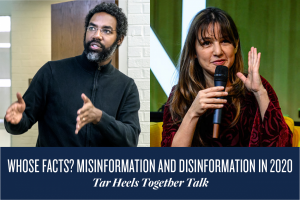Whose Facts?

by Barbara Wiedemann
UNC Hussman School of Journalism and Media Associate Professor Deen Freelon joined forces with UNC School of Information and Library Science (SILS) Dean Gary Marchionini and SILS Associate Professor Zeynep Tufekci for a powerful discussion on Sept. 30 about misinformation and disinformation in the digital age. The event drew an eclectic audience of over 250 people, including many interested Hussman alumni, faculty and staff.
UNC Hussman Dean Susan King welcomed participants and posed questions to the information science scholars during a Q&A for “Whose Facts? Misinformation and Disinformation in 2020” — part of the University’s Tar Heels Together virtual engagement initiative.
Freelon and Tufekci are two of the four leading global public intellectuals who act as principals at the UNC Center for Information, Technology, and Public Life (CITAP), an interdisciplinary initiative founded in 2019 on Carolina’s campus to study how today’s electronic environments affect our world. The center aims to help scholars, policy makers, corporate platforms and the public cope with the challenges of the digital age.
“It is more than a center. It is an intellectual hub,” King said of CITAP’s collaborative work, which brings together scholars like Freelon, principal researcher Associate Professor Daniel Kreiss and Assistant Professor Shannon McGregor from UNC Hussman; Tufekci, Associate Professor Tressie McMillan Cottom and Assistant Professor Francesca Tripodi from SILS; and principal researcher Associate Professor Alice Marwick from the Department of Communications.
Parsing the digital data
Freelon’s research uses digital data to investigate political expression, analyzing sometimes millions of posts for insights.
“That usually means my work is good at figuring out what is going on, but not so much at finding out why,” said Freelon. “For that you typically need to talk to people or at least observe their behavior more closely, and some of my CITAP colleagues are really good at that kind of thing.”
Freelon’s most recent piece, with CITAP colleagues Kreiss and Marwick, concluded that existing research shows that the political right is structurally disposed to disinformation, and uses a strong network of politicians and other elites to share it. Freelon specifies that this doesn’t necessarily mean that the left isn’t generating disinformation, rather that we need more research to find and understand it.
In this week's @ScienceMagazine, @alicetiara, @kreissdaniel and I review recent research on digital activism: https://t.co/iF1LYFqLMn
— Deen Freelon (@dfreelon) September 3, 2020
Tufekci, the author of “Twitter and Tear Gas,” studies the interaction between digital technology, artificial intelligence and society. A contributor to The Atlantic, her September 30 piece there gained immediate attention. It asks if the key to controlling the coronavirus pandemic might lie in studies finding that most people don’t seem to transmit COVID, ie that a small percent is responsible for almost all infections.
❗️Did you know that *study after study* finds most people don't seem to transmit COVID at all? That a small percent is responsible for almost all infections? That R is not that informative? My new piece on why this may be key to controlling the pandemic. https://t.co/59YgSSHdEZ pic.twitter.com/veHa1BRwMO
— zeynep tufekci (@zeynep) September 30, 2020
Both scholars’ insights are in high demand as the public faces the unprecedented challenge of navigating misleading or false information and purposeful information overload to determine what is true.
Expert advice
How can a daily digital consumer of information parse mis- and disinformation from the truth?
Freelon advised seeking convergent evidence: two people who don’t know each other and aren’t working together who have reached the same conclusion, for example.
"Disinformation works through confirmation bias — that is, it tells you things you very much want to be true,” Freelon warned. “This makes it easier to see disinformation targeting the other side than your own."
He also advocated critical thinking.
“Is a source trying too hard to appeal to your confirmation bias? Does it sound too good to be true?“ he asked. “It probably is.”
The Hussman scholar requested a ban on the term “fake news” in favor of using more specific terms like “false news,” “misinformation,” “disinformation” and “conspiracy theories” instead.
“We should drop ‘fake news’ from our collective vocabulary,” he urged. “…When you use it, you run the risk of your audience misunderstanding you.”
Tufekci advocated digital literacy as well, and clarified that she remains a great optimist for what digital technology can do for humanity. She made an intriguing analogy.
“Conspiracies are kind of like scientific curiosity run amok... if you try to connect the dots but let it get unmoored, that's when it goes awry.”
CITAP’s founding in 2019 was recognized by the John S. and James L. Knight Foundation, which provided $5 million over three years in support alongside institutional support of the University, alongside initial support from Luminate and The William and Flora Hewlett Foundation. The center’s ambitions to be a world-class center extend far beyond three years, as Marcionini noted in his presentation, and he welcomed additional support and participation.
CITAP affiliates from Hussman include faculty members Assistant Professor Joseph Czabozsky and Associate Professor Tori Ekstrand; and graduate students Kirsten Adams, Bridget Barrett and Tegan Bratcher, three Roy H. Park doctoral fellows.